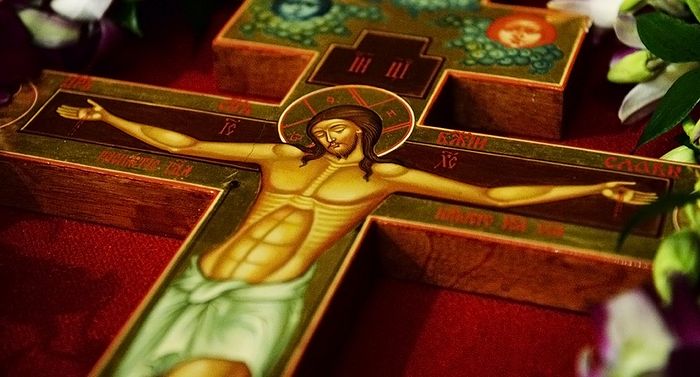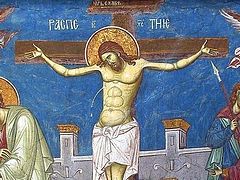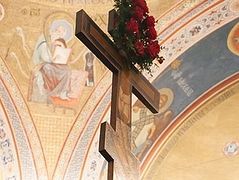In the name of the Father and of the Son and of the Holy Spirit!
O much-hymned Tree of the Cross! O Life-bearing Tree of the Cross! O thrice-blessed Tree of the Cross! O honorable Cross, joyous sign of our redemption!
Show us sinners the path to the salvific life.
Dear friends! “…For the preaching of the cross is to them that perish foolishness; but unto us which are saved it is the power of God (1 Cor. 1:18). Yesterday we visibly touched this power, having participated in the Elevation of the Cross of the Lord. The Life-creating Wood passed by each of us, carried out from the Holy of Holies, from the earthly Heaven, from the altar of the Lord. It passed by and was lifted on high, and descended to the earth to again be raised, overshadowing all corners of the earth, that everyone would see, understand, and feel the power and authority of this great sign of victory.
It’s not by human invention that this wondrous feast has come into the world, combining within itself three events of the Lifegiving Tree at different points in history, and it’s not by human efforts that it has been preserved in the world for seventeen centuries already. The feast’s Gospel reading points to that strength which constantly and absolutely possesses the mutable and impermanent world. The strength and power of the Cross is the great sacrifice—the Savior’s sufferings on the Cross, beginning with His unjust condemnation to death, to the piercing of the ribs of His most pure body, from which flowed blood and water, feeding the world unto Eternal Life. The Gospel ends with the assurance that the truth of this fearful story is testified to by a witness of this Golgotha sacrifice and is transmitted that those who hear it might believe.
The Orthodox Church, born on the eve of the appearance of the Lifegiving Cross of the Lord to the world, and having become in the persons of the apostles a witness to the great podvig of love—even unto death and the death of the Cross—has since then received the sign of the Cross as a salvific symbol for believers, and not just as a symbol, but as a salvific strength, which defeats the enemies.
Testimonies of the veneration of the Cross of the Lord have survived in apostolic writings and in the writings of the teachers of the Church that have come down to us; but the living examples of this power, manifesting in all times, called to life a special canon on the veneration of the Cross, established at the Sixth Ecumenical Council, which took place in the year 680 in Constantinople.
Its 73rd canon reads: “Inasmuch as the Lifegiving Cross has shown us salvation, it befits us to take care to render due honor to that through which we were saved from the ancient fall.”
First, the Cross of the Lord is terrible and glorious, having turned from an instrument of execution into an instrument of power and glory. This Cross, lifted up from the Earth to Heaven, is the innocent and voluntary suffering of Christ the Savior, and with Him are nailed the sins of the whole world. The Cross is soaked with His pure blood and by it cleanses every sinful defilement. The Cross has taken upon itself a host of evil gazes, mockery, and blasphemy. But two people wept at the foot of the Cross: the mother of the Crucified One, through whose own heart passed the weapon of the Cross, and the lone disciple whose love was not frightened by the terror of sufferings.
This Cross was elevated above the world for a short time, to then be long hidden in the earth by human malice; but this short time was enough for the Lifegiving Cross to subdue the world and revivify it.
It was by the long and difficult path of humility that the Lord Jesus Christ entered into His glory, but incomparably longer was the humiliation of the Lifegiving Wood, upon which He offered Himself in sacrifice for the sins of the world. The glory of the Crucified One had already reached unto the ends of the universe, but the Lifegiving Tree of the Cross, hidden in obscurity and shame, awaited its hour for three centuries.
The Cross had already crowned the Church of Christ; the Sign of the Cross, by the power of Christ crucified upon it, was already strengthening the first Christians with their human weaknesses, helped them go to their sufferings for their faith. But the one and only Lifegiving and Salvific Tree itself was still concealed from the sight of man.
Christianity spread and grew stronger. The powers of this world reflected upon the Divine origin of He Who was crucified and lifted upon the Cross. Emperor Constantine the Great was honored, along with all his armies, to see God’s sign—the Cross shining among the stars and the inscription radiating around it: “In this sign conquer.” And the Sign of the Cross gave him the path to many victories in battle.
By this manifestation, the memory of the first Cross of the Lord was revived in the consciousness of Christians, and with it the faith that this great sanctity could not die. By this time, the Church was already filled with many living testimonies to the podvigs of cross-bearing, but she lacked the celebration, and glory, and joy of that singular Cross from which shone the victory over death. Thus, the octogenarian Helen, the mother of the first Christian emperor Constantine, took upon herself the search for the Cross of the Lord. The Holy Spirit inspired this queen (later called the equal-to-the-apostles), to the joy of the Crucified One and to the joy of Orthodox Christians, to invest many labors and efforts in order to find this shrine.
The pagan emperors and evil Jews had tried to wholly destroy the memory of the sacred events and sacred places where our Lord Jesus Christ suffered for man and resurrected. The Tomb of the Lord and Golgotha were covered over with dirt, and a pagan temple was erected on the artificial hill.
And now the Christian empress was seeking traces of the lost treasure among the Jews, hostilely disposed towards Christians.
How great is the power and authority of God, you can judge for yourself: To the empress’ question addressed to the eldest of the Jews: “Where did your ancestors hide the Cross of Christ?”—they pointed her to a certain elder Jew, Judas, who at the repeated question, obviously against his own wishes, led her to the place of the temple of Venus and said, “On this very place you will find the Cross of your Christ.”
Judas betrayed Christ to the Cross, and three hundred years later another Judas contributed to the manifestation of the glory of Christ.
The search yet continued for a long time after the removal of the temple, and hope turned into hopelessness, until the Lord Himself deigned to reveal to people the sacred object resting in the ground. The sweet fragrance of the Holy Spirit coming out of the ground put an end to the search.
But the seekers were again plunged into bewilderment. Instead of the one sought-after Cross, they found three, and they were all exactly the same. The plaque with the inscription that hung on the Cross of the Savior was found later in another place.
St. Macarius, heading the search together with Queen Helen, exclaimed: “If the providence of God does not wish to leave the Cross of the Lord in the ground forever, then can it allow it to remain in uncertainty? Can it allow that instead of the Cross of the Lord, honor would be given to the cross of a thief? God Himself will show us the Cross of our Savior.”
All three crosses were carried into the house of a pious woman lying on her deathbed. After the fervent prayer of the holy hierarch, the crosses were placed one by one on the dying woman. Only by the touch of the last cross did the strength of life enter the sick.
All those present for the miracle unanimously offered glory to the Cross of the Lord, but this identification was too little for the glory of the Lifegiving Wood of the Cross. It pleased the providence of God that the glory of the Cross would shine by those who did not want to confess it, that by the might of the venerable Wood, unbelief and the enemies of the Cross of the Lord would be crushed.
Returning from the home of the healed woman to Golgotha, the Christians met a funeral procession. The pious and full-of-faith hierarch Macarius daringly laid the Cross of the Lord upon the deceased, and the Cross of the conqueror of death and Hell again dissolved the bonds of death, quickening the dead.
News of the perfect miracle, which shook those present, flew throughout Jerusalem in the blink of an eye, and gathered believer and non-believer alike to the foot of the Cross on Golgotha. Countless people desired to see the miraculous Tree, at least from afar.
St. Macarius and Empress Helen, standing on a dais, elevated the Pure Cross as high as possible in all four directions, that all could venerate it. The people, engulfed by pious awe, exclaimed as a multitude, “Lord, have mercy!”
The force of the impact of the Lifegiving Tree was so great that a host of Jews were baptized, including the elder Judas who had pointed out the place of the concealment of the Lord’s Cross, taking the name Cyriacus in Baptism and becoming the bishop of Jerusalem at the end of his life by the mercy of God. He himself ascended to his martyric cross during the reign of Julian the Apostate, in the short span of his life as a Christian.
Thus was accomplished the finding of the Cross of the Lord. 326 years after the Crucifixion of the Savior, the Lifegiving Tree of the Cross of the Lord again became a preacher of the power and divinity of Christ.
“Honorably and righteously venerate the Cross of Christ,” St. Dimitry of Rostov, the Russian Chrysostom, says in his homily on the Elevation, “for by this blessed Tree was death slain and life granted. By the tree of Paradise we were killed, and by the Tree of the Cross we are revived; by the first we were expelled from Paradise, by the second we ascend to Heaven; by the first the enemy defeated us, by the second we defeat the enemies.”
After finding the Lifegiving Cross of the Lord, the equal-to-the-apostles Emperor Constantine ordered the erection in Jerusalem of a majestic and spacious church in honor of the Resurrection of Christ, including within itself both the Tomb of the Lord and Golgotha.
The church was built over ten years and was consecrated on September 13, 335; the Cross of the Lord was erected in the church the next day, and on that day was established the feast of the Elevation of the Precious and Lifegiving Cross of the Lord.
And for the first time that day the Church sang, “Before Thy Cross, we bow down in worship, O Master, and Thy holy Resurrection we glorify!”
Yet another, third event connected with the life of the Cross of the Lord is remembered this same day.
From 614 to 628 the Precious Wood suffered captivity by the Persians. The Tree was kept, by the providence of God, in a foreign land. The pagans, struck by the miracles that accompanied the ark with the Cross, did not dare to touch the sacred Christian object. With the victory of the Greek emperor Heraclius over the Persians, the Cross returned to Jerusalem. The return of the Cross, and its elevation above the Tomb of the Lord was celebrated on the day of the feast of the Elevation of the Lifegiving Tree of the Cross of the Lord.
Thus, my dears, three simultaneous events from the life of the Cross of the Lord consecrate this day, which I repeat as a reminder to you—the finding of the Tree of the Cross, the building of the Church of the Resurrection of Christ on Golgotha, the bearing of the Lifegiving Cross into this church, and the final return of the Lifegiving Tree from captivity and its installation on Golgotha on its original place.
Twenty centuries have passed since the great events of the Savior’s sacrifice on the Cross on Golgotha, when Christ ascended into Heaven in glory. The Cross remained on earth, continuing the great deed begun on Golgotha. And the Cross lives to this day, as a living person, taking upon itself both unlimited love, and equally unlimited hatred.
As at the first saving Cross of the Lord, love and hatred and loyalty and betrayal withstood one another—as it should be—so the Cross is a stumbling block to the life of the world in all times. For some—the godless—it is relentless and hateful to the arena of sufferings which lead to death. The grief and suffering of this earthly life is the lot of all those born on earth. For others—the followers of Christ—the cross of such sorrows and sufferings becomes the beloved arena of the highest spiritual enjoyment, walking the path behind their beloved Christ to life eternal in glory.
The Cross continues to live in the world—for some unto salvation, and for others unto destruction. The battle of good and evil at the foot of the Cross continues for the sake of love and hate of Him Who sanctified the Wood of the Cross.
We don’t have to go deep into history for examples—let’s take the living examples of our days. What malice and rejection of the Cross do we see now in all those who have departed from the Orthodox Church of Christ, and especially in the Protestants and sectarians who blaspheme the Cross of Christ and our Sign of the Cross, and accuse the Orthodox of idolatry for venerating the Cross. The Cross as the keeper of the entire universe, the Cross as the keeper and confirmation of every man in truth does not exist for them.
With the rejection of the Cross, they reject the very path of salvation, the path of following after Christ, and they become the plaything of the demons on the path to perdition.
Another example: In 1992, love for Christ gathered pilgrims from the whole world to Jerusalem for the feast of the Bright Resurrection of Christ. The Holy Fire hadn’t even gone out in the lampadas, and in their hearts they yet trembled, having just experienced the miracle of the descent of the Divine grace and the Paschal Resurrection joy, and the Paschal week as one day, glorious in the Church of God, when a blasphemous, defiant heart, breathing malice, had already prepared a terrible act of blasphemy. On Saturday of Bright Week, the criminal hand uprooted the Holy Cross which stood so many centuries on Golgotha.
But God is not mocked. The scorner cursed himself. The Lord saw this battle from the heights of His glory, and invincible is the victory—the Cross of Christ—given to the faithful as a weapon against enemies, visible and invisible, unto the last day of the world, unto the day of the glorious and dread second coming of the Lord.
The appearance of the Lord of Glory on the Earth will be revealed as nothing other than the great sign of the Cross of the Lord in the heavens, which all peoples of Earth will see; which every person will see. They will see it, and weep, and tremble.
It will be the third great appearance of the Cross, in anticipation of the appearance of the Savior at the Dread Judgment.
Let us affirm, my dears, our intentions by the Lifegiving power of the Cross of Christ; let us fix our reverent attention upon it, and especially on this present day of the feast of its elevation and its glorification in our heart and bodies; let us bow before the Cross in tenderness of heart, and in contrition of spirit, for it is impossible to worthily glorify the incomprehensible power and majesty of the Cross of the Lord.
And that we would at least to some small degree be prepared to receive this unfathomable manifestation, the Holy Church commands us by its Typikon: “On the day of the Elevation, cheese, and eggs, and fish we dare not touch,” because the veneration of the Cross consists in the mortification of the flesh.
O, merciful Lord, by the invincible and Divine power of Thy Cross, do Thou protect, bless, and save us! Amen.
September 14/27, 1993



